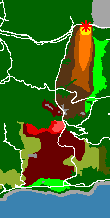| Download the Source Code |
 |
zip archive 890445kb |
tar.gz archive |
compiled Win32 executable 450181kb |
compiled Win32 executable with PNG support 871697kb |
| Source Code Documentation ver 1.0.0 |
|||||||||
| HFire (Highly Optimized Tolerance Fire Spread Model) is a new raster-based spatially explicit model of surface fire spread through Southern California chaparral written in the C programming language. Using HFire you can predict the speed and direction of a fire spreading across the landscape in real-time. HFire can also be used for stochastic multi-year simulations of fire regime. | Basics | ||||||||
| The HFire model is a product of research funded by NASA through the Southern California Wildfire Hazard Center. HFire is also the basis of my masters thesis at the University of California, Santa Barbara. I have released all of the source code under the GNU Lesser General Public License. The native output of the simulation is ASCII raster files showing predicted fire spread. ASCII raster files can be read by any general purpose geographic information system (GIS) or remote sensing software. The simulator also supports the output of PNG images if you have the fantastic open source gd library installed on your machine. See the makefile included with the distribution for more details on enabling this option. The html documentation generated from the HFire library source code is a good place to go if you are interested in extending the capabilities of HFire or developing your own simulator. HFire is written in C. In order to support model intialization from a wide variety of input data source formats without the benefit of an object-oriented system, I used tables of function pointers to achieve polymorphism. A good example is the FireEnv struct. The documentation for the HFire configuration file is a good place to scope the features available from the library. | |||||||||
| Technical Details | |||||||||
| HFire uses the Rothermel fire spread equation (Rothermel, 1972) to determine the direction and magnitude of the maximum rate of fire spread into a cell. One-dimensional predictions from the Rothermel equation are fit to two-dimensions using the solution to the fire containment problem (Albini and Chase, 1980) and the empirical double ellipse formulation of Anderson (1983). A new technique implemented in HFire, based upon finite fractional distances between cell centers, remedies the problem of distorted fire shapes previously identified as endemic to raster models of fire spread (French, et al, 1990). | |||||||||
| Resources | |||||||||
|
|||||||||
 1.2.3 written by Dimitri van Heesch,
© 1997-2000
1.2.3 written by Dimitri van Heesch,
© 1997-2000